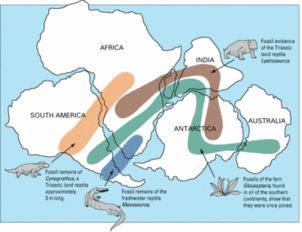Stratigraphy
Stratigraphy is the study of layered rocks as well as all layering processes that contributed to rock formation. Stratigraphy disciplines include: Lithostratigraphy, Biostratigraphy, Chronostratigraphy.
Lithostratigraphy is perhaps the best evidence for a Gondwana continent. Evidences include Precambrian rocks shields (e.g. Congo craton in Central Africa and Sao Francisco Craton in Brazil), flood basalts (India and Australia), similar stratigraphic sequences (age of volcanic rocks, tillites, coal beds, etc.). Pan-African belts particularly can be traced back in time to about 1000 Ma from Africa into South America, Antarctica and Australia. The dominant tectonic activity of these belts took place between 800-450 million years ago. It is thought by many geologists that these belts contain suture zones along which various types of late-Paleozoic ocean basins closed. According to these scientists the orogenic belts may thus represent welds between large and small scale fragments that collided in the late Proterozoic-early Paleozoic and fused together to form Gondwana. It has long been observed that large regions of the intervening Precambrian terrains have undergone extensive thermal rejuvenation about 600-450 million years ago: it is probable that this period coincides with the culmination of collisions, welding and rapid uplift of the building blocks of Gondwana.
Flora and fauna are found in various geological environments on the continents formed following Gondwana break-up: Mesosaurus fossils are found in Brazil and South Africa, Lystrosaurus, a fat mammal-like herbivorous reptile lived in Africa, Southeast Asia and Antarctica.
Paleomagnetic data from all the continents (South America, Africa, Antarctica, Australia) can be used to study the development of Gondwana, as the rock units formed during this period will contain similar paleomagnetic signatures . When traced across continents, these paleomagnetic signatures show consistent trends with periods of rock formation. As a consequence, there is a remarkable agreement on an overall reconstruction of Gondwana circa 150 million years ago; vindicating du Toit (1937), Smith and Hallam (1970) reconstructions.
